Technology has become a staple in today’s optometric practice; gone are the days when a Snellen eye chart and a phoropter were all you needed to care for the majority of your patients. Today, autorefractors, digital fundus cameras and optical coherence tomographers (OCT) are just a few items that grace your office space and help you provide exceptional patient care. But with this technological boom comes a constant need to upgrade—and often with a big price tag.
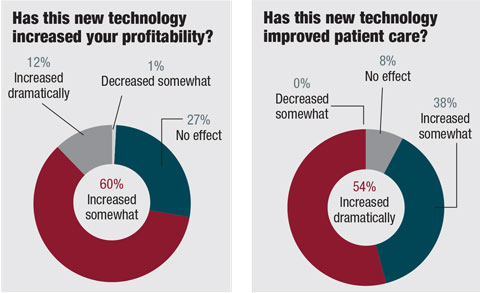 |
What did you invest in this year? How has it impacted your patient care? Your bottom line? We asked, and you answered. See what your colleagues spent their money on this year and what they still have on their wish list in our 2016 Technology Survey.
Must-Have’s
Practitioners seem to be sinking their money into the same go-to technology each year, with electronic health records (EHRs), digital fundus cameras, patient callback/reminder systems and tonometers making the top five again. The surprise came with spectral-domain optical coherence tomographers (SD-OCT), in the top five last year at 20% of new purchases, being knocked out of the running by automated refraction systems. Only 13% of respondents purchased an automated refractor in last year’s survey, but 23% of this year’s survey takers said they invested in one. Those who did so focused on two key benefits: patient experience and exam efficiency.
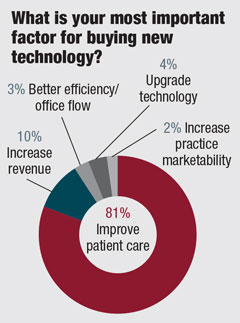 |
“It made the flow of the exam much faster and patients’ experience much more interesting by actively participating in getting a new pair glasses,” one respondent said of her new automated refractor.
“Patients love the technology, and refractions are smoother and take less time,” another survey taker said.
It’s no surprise patient experience was key with these purchases, as 81% said the impetus for new technology was improving patient care. And improve it did. Whether it was an autorefractor, a retinal imaging system or tonometer, 94% said their technology upgrade improved patient care. The good news is that it also seems to translate to better budgets, as 74% said their new purchase increased profitability as well.
Paying the Piper
Although it’s a huge benefit to your practice to have the best technology on the market, it can be tough to designate thousands of dollars for just one piece of equipment—especially considering the sheer number of tools at your disposal. Most survey takers, 41%, said they have limited their new tech budget to less than $10,000 this year, but a lucky 11% will have more than $50,000 to play with.
Others are getting creative to find ways to afford that new visual field analyzer or tonometer. Twenty percent of respondents plan to lease their next major piece of equipment, and 12% said they share equipment with another practice. And with technology advancing at breakneck speed and making that new camera or patient callback system outdated in a few short years, 80% agree that buying new is a better investment than refurbished or used instruments.
The hefty price tag is often easier to swallow when the new toys provide a direct financial benefit to the practice. Many purchases, such as the much-in-vogue autorefractor, increase practice productivity, so you can see more patients in a day. Others, such as an OCT, can help keep patients in the practice by reducing unnecessary referrals.
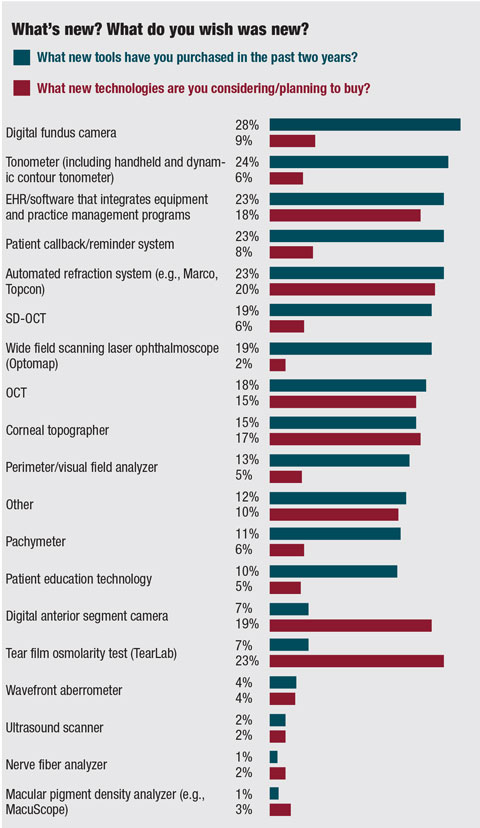 |
“The purchase of our OCT has made our patient care better. We’ve become more efficient in knowing when to follow and when to refer, not to mention it has made practice lots more fun!” one respondent said. “It certainly has revolutionized the way we practice like no other piece of instrumentation has; we are on our third OCT now and could not imagine practicing without it!”
“Our SD-OCT has allowed the diagnosis of early hydroxychloroquine toxicity, confirmation of macular edema, epiretinal membrane and other causes of reduced visual acuity that previously may have only been suspected and required referral to retinal specialist,” another survey taker said. “Also, it’s an added diagnostic tool for glaucoma management, especially for those unable to do threshold visual fields.”
With rave reviews such as this, it’s no wonder nearly 40% of survey takers invested in an OCT or SD-OCT this year.
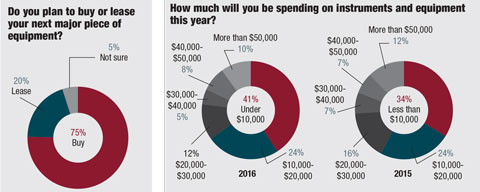 |
Front Office Upgrades
Diagnostic technology, such as automated refractors and widefield retinal imagers, may “wow” patients in the exam chair, but the equipment behind the scenes is just as important. Keeping the front office running smoothly is a necessity in a busy practice, and this year 56% of survey respondents made room in their budgets for EHR, a patient callback system or patient education system—all in the name of productivity and employee satisfaction.
“We literally ran out of space for physical files,” one survey taker said of his EHR purchase. “Having the data in the cloud has been much more efficient.”
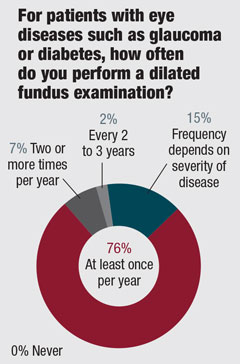 |
Another practitioner is thrilled with her new electronic recall reminders: “We can have staff work on other items besides call patients,” she said. “When a doctor is unable to come in to work on a spur of the moment, we text our patients that we need to reschedule and it saves a lot of time and lets the patient know right away their appointment needs to be adjusted. The few times we have had to use this, it has been a lifesaver.”
She isn’t the only one singing her new callback system’s praises. “[Our new] automated patient appointment reminders and recall system dramatically increased revenue,” another OD said. “It reduced no-shows by 75% and led to 207 past-due patients making appointments in the first six weeks of use. I am now booked ahead an incredible 880 appointments and they all show up!”
Despite the anecdotal success of these systems, they don’t seem to make it onto many optometrists’ wish lists. In last year’s survey, only 8% of respondents said they would be in the market for a patient callback system in the next year. And yet, far more than 8%, 23% in fact, said they purchased one this year. An EHR or patient callback system might not be the sexiest purchase for your practice, but it provides an invaluable service that many practices say is worth the price—keeping you and your staff on schedule and up-to-date.
What’s on Deck for Next Year?
Even if your practice held off on upgrading this year, it’s inevitable you will be making some big purchases in the future. Last year, OCTs topped the wish list, but this year 23% of practitioners have their eye on a more specialized tool: a tear film osmolarity test (Tearlab). Those who already knocked this off the wish list are glad they did. It provides data for both doctors and patients to help monitor dry eye, and its “small reimbursements can add up,” one respondent said.
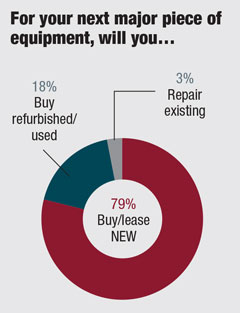 |
“DES is everywhere,” said another respondent who purchased a tear film osmolarity test this year. “It is treatable at all stages, it generates increased revenue and makes patients feel and look better.”
Another item on many wish lists is a digital anterior segment camera. While only 7% bought one this year, 19% have moved this one to the top of their list for next year.
Other contenders penciled into next year’s budgets are automated refractors (20% are looking to buy one), EHRs (18%) and corneal topographers (17%). But who knows? Maybe those ever-so-useful patient callback systems will sneak into the budget—like they seem to do every year.
The best news from all of your colleagues concerning new technology is that, for the most part, no matter what you spend your money on, it will improve patient care. If you are lucky, and use your new tools correctly, it can also boost your practice’s productivity and your bottom line—giving you a little more dough to invest in new technology next year.
